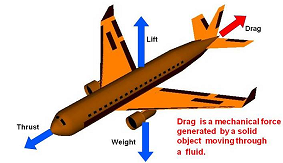The Force of Drag equation, Fdrag= ½⋅(ρ⋅A⋅Cd⋅v²) ,  Forces on motion in flight. calculates the resisting force of drag on an object flowing through a medium (e.g. air).
Forces on motion in flight. calculates the resisting force of drag on an object flowing through a medium (e.g. air).
INSTRUCTIONS: Choose units and enter the following:
- (ρ) Density of air with a default cited below.
- (Cd) Drag Coefficient.
- (A) Surface Area.
- (V) Velocity.
Force of Drag (Fdrag) The force of drag or air-resistance is returned in newtons. However, this can be automatically converted to other force units via the pull-down menu.
The Math / Science
The formula for the force of drag is:
where:
- Fdrag is the force of drag
- ? is the density of the medium (e.g. density of air)
- A is the cross-section area
- Cd is the drag coefficient
- v is the velocity
Measured Drag Coefficients (Cd)
The graphic shows some common drag coefficients based on the shape of the object. Note, that there are other factors besides shape that can effect drag.
Graphics courtesy of Wikipedia (Drag coefficient)
Density of Air
The density of air, ? (Greek: rho) (air density), is the mass per unit volume of Earth's atmosphere. Air density, like air pressure, decreases with increasing altitude. It also changes with variation in temperature or humidity. At sea level and at 15 °C, air has a density of approximately 1.225 kg/m3 (0.001225 g/cm3, 0.0023769 slug/ft3, 0.0765 lbm/ft3) according to ISA (International Standard Atmosphere).
- At IUPAC standard temperature and pressure (0 °C and 100 kPa), dry air has a density of 1.2754 kg/m3 (the default above).
- At 20 °C and 101.325 kPa, dry air has a density of 1.2041 kg/m3.
- At 70 °F and 14.696 psi, dry air has a density of 0.074887lbm/ft3.
See Also
References
- Wikipedia - http://en.wikipedia.org/wiki/Drag_coefficient
- Wikipedia - http://en.wikipedia.org/wiki/Density_of_air
- Light and Matter(Dr. Benjamin Crowell) Chapter 4.3 Newton's Second Law